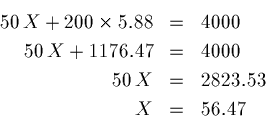
Another technique for finding where the lines cross, is to adjust one equation, so that you can reduce the 2 equations in 2 unknowns, to a single equation in one unknown.
Start with the 2 equations to solve


Substituting this value of Y back into the first equation,
![]() ,
gives:
,
gives:

So the solution is (X = 56.47, Y = 5.88). Rounding these
numbers (as we can't install fractional networks) gives
56 Type A networks and 6 Type B networks, indicating that
the profit will be
![]() .
.